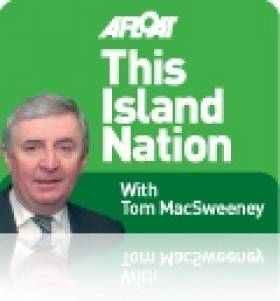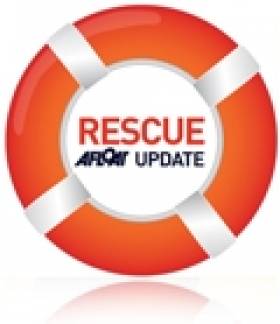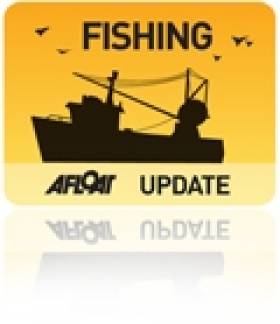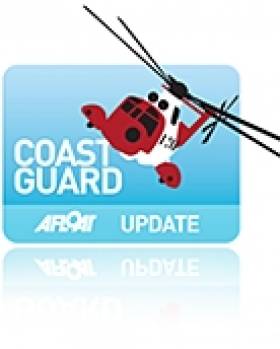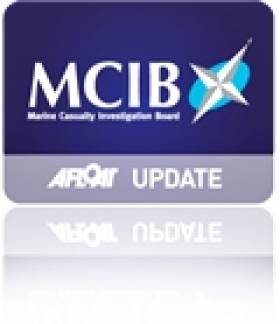Displaying items by tag: Fishing
Ending Fish Discards Requires New Technologies - Damanaki
#Fishing - Key to proposals to end fish discards in this year's reform of the Common Fisheries Policy (CFP) is the introduction of new technology like wheelhouse cameras and 'smart nets'.
So argues EU Fisheries Commissioner Maria Damanaki, as BBC News reports on trials of new net designs that can separate fish catches and reduce damage to the seabed.
One of the fishing net innovations involves a bendable plastic grid attached to the middle of a trawl net that allows smaller fish and juveniles to pass through while snaring the valuable larger catch.
Another design, the Rollerball net, attempts to eliminate the problem of heavy trawling gear churning up debris on the sea floor while reducing drag and saving on boats' fuel bills.
Assuaging concerns over the prohibitive costs for fishermen, Damanaki says she hopes that such 'smart nets' will be subsidised by as much as 85% - while emphasising that the adoption of new technology could mean the difference between being allowed to fish or being banned from the ocean.
Wheelhouse CCTV cameras are another method that has been shown to reduce discards to less than 1% in some cases - and Damanaki says they will be essential if the CFP reforms indeed include a zero tolerance policy on fish discards.
BBC News has much more on the story HERE.
West Cork Weekends Will Bring You Closer To Marine Wildlife
#MarineWildlife - If you've ever wanted to get closer to Ireland's marine wildlife, a new series of weekend excursions in West Cork may be just the ticket.
The Southern Star reports on the 'Discover Wildlife Weekends' being run from Rosscarbery by local company Ireland's Wildlife starting this April, where those taking part will be led by expert guides to explore the coastal region and have the best opportunities to spot the many species of whales and dolphins that visit our shores.
Weather permitting, the weekends will also involve some offshore whale watching in the company of 'whale watch supremo' Colin Barnes and the Irish Whale and Dolphin Group's (IWDG) sightings co-ordinator Pádraig Whooley.
And birdwatching will also be a feature, as West Cork is a hotspot for our feathered friends - from merlins and peregrine falcons to coastal waders and more exotic fowl that skirt our coasts on their spring migrations.
The Southern Star has much more on the story HERE.
Meanwhile, marine sector stakeholders have expressed their concerns over the designation of six new offshore marine areas by the National Parks and Wildlife Service.
As previously reported on Afloat.ie, the six sites at Blackwater Bank in Wexford, the West Connacht coast, Hempton's Turbot Bank in Donegal, the Porcupine Bank Canyon off Kerry, the South-East Rockall Bank, and the stretch from Rockabill to Dalkey Island off Dublin have been proposed for designation as Special Areas of Conservation (SACs) to protect marine habitats and species listed on the 1992 EU Habitats Directive.
But at a recent meeting at the Irish Farm Centre in Dublin, a coalition of fish farmers, fishermen and marine energy stakeholders have hit out at what they characterise as "the appalling handling of inshore designations since the 1990s by the State", which they claim "has resulted in hundreds of job losses and a flight of serious investment" from Ireland's coastal areas.
“Our experience of the Irish Government’s application of the EU Habitats Directive has been a saga of mismanagement, foot dragging and buck-passing which has left over 500 fish farming licences in limbo for over 10 years and a backlog of red tape and bureaucracy which could see producers waiting until 2020 and beyond for simple renewals which are vital to underpin their businesses," said IFA aquaculture executive Richie Flynn.
"These new offshore SACs will have the same effect of preventing any fishing, marine energy or aquaculture being carried out in these areas if left in the hands of the same agencies to manage."
Searching for Trawlers, Sailing Solo, Salp & Parking Your Boat
Fishing – THE MAN WHO SEARCHED FOR 60-FOOTERS
#islandnation – Can you imagine spending years searching for old 60-foot boats, travelling the country's coastline because of a 'bug' within your system?
Pat Nolan from Cork, who now lives in County Antrim, has done that, "a labour of love, meeting with many wonderful people" who sailed these iconic vessels.
Six years ago he began tracing the histories of all eighty-eight 50-foot fishing boats built by the State fisheries board, Bord Iascaigh Mhara between 1949 and 1970, a mammoth task which he completed in two years and published in a book called 'Sea Change'. Now he has six books about fishing boats to his credit, the latest called 'A Step Up' and which, logically enough perhaps, is a record of the BIM 56-footers which were regarded as a 'step up' when introduced to Irish waters for commercial fishing.
Understandably, Pat comes from a family steeped in commercial fishing activities, into which he was born in Baltimore in West Cork. A science graduate of University College, Cork, he worked in Nigeria for a number of years before returning to Ireland and settling in Ballycastle.
He has compiled individually-traced histories of all 39 BIM-built 56-footers, a huge contribution to the archive of Ireland's maritime history. Built at several boatyards around the coast, their construction provided great employment and underwrote the shipwright tradition in Ireland which has now, unfortunately, declined to the great loss of the marine industry. Tyrrells of Arklow designed their own 56-footers for BIM.
"That all 56-footers were not identical is beyond dispute, differences existed in detail, layout and even design, but the boats were readily recognisable, regardless of variations," says Pat. "All of the boats were well-built, efficient and regarded as 'small big boats' and first-class weather boats. Yet I'd have to say there are divided opinions as to how well they met the requirements of their era, even though they were iconic boats."
Safety – ALONE ON THE WATER
My report last week that the Coast Guard had tried to get the Marine Casualty Investigation Board to make a strong recommendation against going out on the water alone drew quite a reaction from readers, varying from "nannyism" to "why can't there be mandatory licences for boating."
"What does the Coast Guard know about single-handed sailing or good seamanship for that matter? It's the same as the priests giving marriage guidance courses," Emailed Gerry Burns.
Trudy McIntyre commented: "For driving a car you need a licence and mandatory driving classes, before you go at it alone!! Why can't there be the same for pleasure boating?"
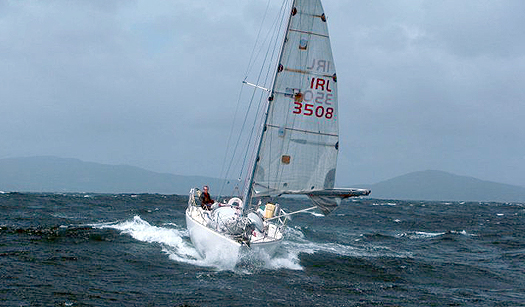
Barry Hurley sailing to solo success in Dinah
Rory described the call as: "More dictatorship and nannyism!" while Tony O'Leary wrote that "the RNLI and Coast Guard are volunteers who at the end of the day are only trying to help people when they are in trouble. In most Lifeboat and Coast Guard crews there are people who have a vast amount of experience at sea" and Jerome Lordan wrote: "Lifeboat crews and Coastguards today do not for the most part have long-time experience at sea like they had in the past when these units were manned by experienced fishermen and ex-seafarers. They seem to think you can just train up and that is sufficient. You cannot buy or train long-time experience at sea!"
Obviously a topic that raises very different opinions, amongst which are the kayakers, canoeists and solo-rowers who told me that they venture out alone as part of their sport. It should be remembered also that Irish solo sailors have achieved success in racing internationally, such as Barry Hurley from Cobh and a member of the Royal Irish YC in Dun Laoghaire with his boat Dinah.
Shipping – IRAN'S FIRST TANKER
Having shown off its first, though somewhat unusual-looking submarine to the maritime world, as I reported a few months ago, Iran has now introduced the first oil tanker it has built. Iran Shipbuilding and Offshore Industries Complex Co. (ISOICO), manufactured the ship which is 178 metres long, 32 metres wide and has a 9-metre draft according to ISOICO. Operated by the National Iranian Tanker Company, it is reported to have cost US$30m. and to be capable of carrying 35,000 tons of oil products. Its maiden voyage has been undertaken in Persian Gulf waters.
Marine Environment – SEEN A SALP?
If anyone sees a salp in Irish waters, notify the authorities at once because these gelatinous sea creatures are another example of the alien species which are not welcome visitors. Last Spring they clogged intake pipes at California's Diablo Canyon nuclear-power plant which caused it to be shut down. Now they have shown up on the Washington coast, having somehow rounded the USA. Some fishermen have found them in nets and older fishermen can remember when they were last seen 30 years ago. Marine scientists have no idea why they are arriving in big numbers. "Weird," is one description.
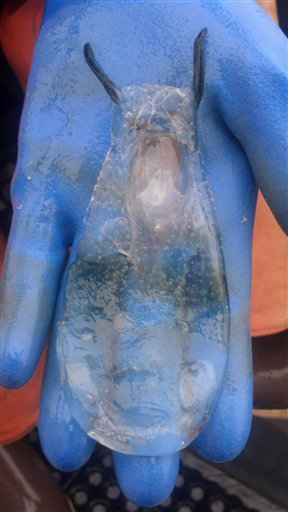
They look like a jellyfish, about the size of a human hand, with a hard head and a few tentacles. Scientists describe a salp as a pelagic tunicate which lives in the open ocean and has a tubelike body that pumps water for locomotion and to filter the plankton on which it feeds. Despite its translucent appearance, it is not closely related to jellyfish. It's a chordate, which means it has a spinal cord and is related to vertebrates. Salps can swim alone or in rope-like colonies. They have the ability to reproduce rapidly and can bloom when the plankton supply is rich. Marine scientists disagree as to whether their appearance is a sign of climate change in the sea.
Boats Wanted – DISCARDS AND SELECTIVITY
The State fisheries board, Bord Iascaigh Mhara, is going to carry out trials aimed at minimising discarding of fish and improving the use of fishing gear to avoid by-catches. Fishing vessel owners who would like to offer their vessels for use in the trials, as well as fishing gear and chandlery suppliers, are being invited to contact BIM, Crofton Road, Dun Laoghaire, Co. Dublin - Phone 01 2144100 Email:[email protected]
Oh No! – NO WAY TO PARK
Noisy parkers are a problem ashore, but if you have ever had trouble entering a marina, this video should be interesting.
Email: [email protected]
Regular news on Twitter: @Afloatmagazine @TomMacSweeney
Body Recovered From Irish Sea Could Be Missing Rush Man
#Missing - A body recovered from the sea off north Co Dublin yesterday may be that of a man who went missing from Rush at Christmas.
The Irish Independent reports that a post-mortem is being carried out on the body to confirm if it is that of 24-year-old Paul Byrne, who was last seen in the early hours of Christmas Day.
Fishermen in the Irish Sea made the grim discovery in their nets yesterday and brought the body to Skerries harbour after 8pm.
The Irish Independent has more on the story HERE.
Coveney Seeks Agreement From EU Marine Ministers On Discards Ban
#Fishing - Minister for the Marine Simon Coveney will be seeking agreement from his European colleagues at next week’s Fisheries Council on how when and how introduce an effective discards ban in the context of the reform of the Common Fisheries Policy (CFP).
At the June 2012 Fisheries Council, ministers did not reach agreement on how a discard ban would be implemented or when such a ban would be introduced.
The challenge for Minister Coveney as president of the European Council of Fisheries Ministers is to secure wide agreement at council on an ambitious early date for the introduction of a ban in all waters across the EU from the Baltic & North Sea to the North Eastern Atlantic, the Mediteranean and the Black Sea.
Ministers will need to agree the practical measures that will ensure that the ban is capable of being effectively implemented in all these areas.
In a review of global discarding, the Food and Agriculture Organisation of the United Nations (FAO) noted that the North East Atlantic has the highest discard level in the world, estimated at 1.3 million tonnes, the majority attributed to EU fisheries. The EU Commission itself estimates that 23% of all fish caught by EU vessels are discarded.
Discarding occurs in almost every fishery, in every area and across most fleets in the European Union. Every member state operating fishing operations on the open sea has a discard problem. Many member states have significant levels of discards in certain fisheries, and for varying reasons.
The policy to stop discarding of fish and to change behaviour of fishermen so that unwanted by-catches and juvenile fish are no longer caught must be seen as an integral part of fisheries management in general and serve the overarching goals of moving to long-term management based on ecosystem considerations and reaching maximum sustainable yield by 2015, where possible, and by 2020 at the latest for all stocks.
The three European institutions, all member states and importantly the Irish presidency are fully supportive and committed to the introduction of a discard ban.
A very important element of delivering the overall objective will be the introduction across all fisheries of smarter and more selective fishing gear, strengthened selectivity measures and changed fishing practices that avoid to the greatest extent possible unwanted catches particularly those of juvenile fish.
To assist the debate on discards and facilitate actions to resolve the problem, Ireland published a 'Discards Atlas' detailing the full extent of discards by the Irish whitefish fleet. It is critically important that other member states do likewise to support the introduction of the new policy and inform measures that will be needed to ensure that a new policy is fully implemented by EU fishing fleets.
Minister Coveney commented: "I am and continue to be a strong advocate for a policy which eliminates the wasteful practice of discards.”
On the prospects for council, he said: “I am under no illusion of the challenges the effective implementation of a discards policy pose for European fishermen and for the member states of the EU, and will work intensively with my European ministerial colleagues over the course of the February Council to deliver a policy with an ambitious timetable for implementation that will end the discarding of fish and support the rebuilding of fish stocks and the future of coastal communities depending on fishing.
"It is my firm belief that the success or failure of the reformed CFP will be judged to a large extent on the effectiveness of whatever discard ban is introduced and that there is widespread support for the ban from the fishing nations of the EU and their fishermen.
"It is imperative that European fisheries ministers collectively take this progressive but challenging decision now and co-operate in agreeing appropriate and effective measures to eliminate discards with ambitious timelines."
Agreement in the council will free up the Irish presidency, on behalf of the council, to begin negotiations with the European Parliament and Commission to reach political agreement on a new reformed Common Fisheries Policy by June.
Five Rescued From Stranded Fishing Vessel Off West Cork
#Rescue - The Irish Times reports on the rescue of five fishermen of West Cork this morning (21 February) after their fishing trawler was stranded in strong coastal winds.
RNLI Castletownbere's lifeboat crew responded to the trawler Anders Nees after its propeller fouled some 6km south of Bere Island in the early hours.
The stricken fishing boat was subsequently towed back to Castletownbere.
Irish Harbours Get €7.4m Funding for Remedial Works
#IrishHarbours - Funding of €7.4 million for urgent remedial works at six regional harbours has been announced by Minister for Transport, Tourism & Sport Leo Varadkar.
The funding will pay for repairs and safety works on essential harbour infrastructure, and is likely to benefit the local economy, promote leisure activities and support the fishing industry.
“This funding will allow essential works at these regional harbours on piers, walls and harbour structures," said the minister. "This work is necessary as part of their transfer from central Government to local authority control.
“Harbours play an important role in their communities in terms of fishing, cargo and leisure and play an increasingly important role in tourism and watersports."
Minister Varadkar added: "The large-scale safety or construction projects planned for Kinsale, and for Baltimore & Skibbereen Harbour this year will be able to go ahead thanks to this funding. Smaller scale projects at other harbours can also proceed, including essential works at Arklow Harbour.”
The funding has been allocated to the following harbours:
Arklow - €3,588,000
Baltimore & Skibbereen - €1,165,000
Bantry Bay - €100,000
Kinsale - €1,467,000
Tralee & Fenit - €750,000
Wexford - €329,500
The funding has been concentrated on remedial works to ensure that the harbours are in a fit condition during their transfer to local authority control.
Twelve of the 13 regional harbours have transferred to date, with 11 being taken over by local authorities, and one designated a fisheries harbour.
Cast Your Nets to Skipper & Angling Shows
#SkipperEXPO –Within a fortnight two shows will be held on either side of the country, the Irish Skipper Expo (1-2 March) in Galway and as previously reported starting today, the Ireland Angling Expo Show in Dublin.
The Skipper Expo Show to be held at the Galway Bay Hotel (10am-5pm each day) will have among its exhibitors, leading seafood processor companies, boatyard firms, net-suppliers, marine electronics, engineering businesses and chandlers. Admission is free, for further details click HERE.
The Angling Expo Show at the National Show Centre, Swords, now in its 14th year, has become a major national event for anglers here and from the UK. According to a recent survey, there are 250,000 anglers alone in Ireland, not to mention angling tourists across the Irish Sea.
Coinciding with the show there will be the Irish Speciman Fish Committee Awards Day, which takes place this afternoon at the nearby Bewleys Dublin Airport Hotel between 2.30-4.30pm.
Also at the show will be the Dublin Angling Initiative (DAI) Kid's Zone, and where many of the country's most experienced anglers will be passing on expert knowledge.
To see list of the exhibitors and admission charges, click HERE.
Fisherman Dies Of Head Injuries Off Kinsale
#Coastguard - The Irish Times reports that a fisherman has died after sustaining head injuries in an incident off the Old Head of Kinsale last night.
The man, one of three crew on the West Cork-based fishing trawler Liberty, is believed to have died from his injuries on board the vessel.
According to TheJournal.ie, the Courtmacsherry RNLI lifeboat and Irish Coast Guard helicopters from Shannon (Rescue 115) and Waterford (Rescue 117) were all scrambled to the scene.
The deceased was airlifted by Rescue 117 to Cork for transfer to hospital, while the remaining crew returned to Kinsale this morning with the lifeboat crew.
It is thought that the accident involved trawling wires on board the fishing boat.
Neglect of Safety Procedures Led To Leg Injury on Fishing Vessel - MCIB
#MCIB - The dangers of performing maintenance tasks on boats while machinery is running have been highlighted in the official investigation into an accident on a fishing vessel off Erris Head in Co Mayo last year.
The skipper of the MFV James Collins was seriously injured when his leg was caught in the vessel's propeller shaft while attempting to clear debris from the bilge pump on the morning of 20 April 2012.
Jonathan O'Donnell, aged 26 at the time, suffered significant soft tissue damage to his left leg and broke his trivia, fibia and ankle in the incident. Luckily the leg did not require amputation and he is expected to make a full recovery.
The report into the incident by the Marine Casualty Investigation Board (MCIB) found that the vessel's bilge pump was located in the hold adjacent to the propeller shaft, with access to both prevented by the same covering boards.
When O'Donnell responded to a persistent bilge alarm, he did not put the engine on stop or into neutral and the propeller shaft remained turning when he removed the covering boards to access the pump.
As he put his foot into the bilge beside the shaft in order to reach down and clear debris, his waterproof leggings were caught by the coupling on the shaft and his leg was round around it twice.
The MCIB noted the quick actions of the vessel's crew and the prompt attendance of RNLI lifeboat and Irish Coast Guard helicopter crews as instrumental in O'Donnell receiving swift treatment and not losing his leg.
However, the report also pointed to a lack of attention to proper safety precautions on board, nothing that the skipper was "too intent on solving the bilge pump problem" and that he "neglected basic safety procedures" by not stopping all machinery before accessing the bilge as set out in the Code of Practice for Fishing Vessels.
The report concluded that the "ease with which debris could enter the bilge and block the pump suction" was a contributing factor to putting the skipper in his predicament at the time, and also referenced the ease with which loose-fitting clothing like waterproofs can be snagged on turning machinery.
Moreover, the screening of the propeller shaft by covering boards also used to access the bilge pump did not present adequate protection "enabling it to be easily exposed and present a hazard".
The MCIB recommends that the Code of Practice be amended to highlight the danger of accessing the bilge area when shafts are rotating, and to include assessment of sole boards in fish holds to prevent debris passing through to the bilge tank. The complete report is available to download below.




























